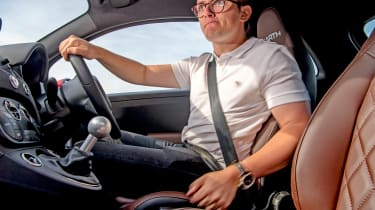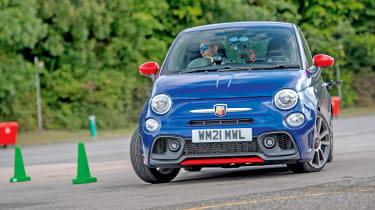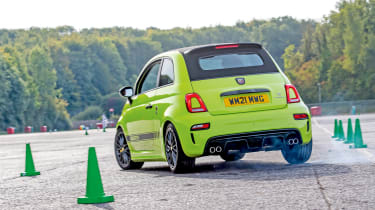How to do a handbrake turn
Manual handbrakes have become increasingly rare, so we learn the art of the handbrake turn while we still can
Sometimes, it’s easy to know when a relationship is on the wane: you start to see the person less and less, and wonder whether someone else could ever provide the excitement you once thought only they could.
For many, this is how we feel about our connection with the beloved manual handbrake. As we embrace this new, digital age, manufacturers are routinely swapping traditional levers for minimalist electrical switches. While these do help remove clutter from a car’s centre console, they aren’t as involving as their analogue cousins and don’t allow you to engage in any kind of hooliganism such as handbrake turns.
With this in mind, Abarth invited us to say a fond farewell to the manual handbrake in the most fitting way: a stunt driving day at Brands Hatch. Who said romance is dead?
Arriving bright and early at the former home of British Formula One racing, my tired eyes are quickly widened by the trio of brightly coloured Abarth 595s that await our arrival. Curiously, all three are equipped with different exhaust systems. The lime green Competizione is fitted with Abarth’s own Monza system, while the white, track-ready Essesse features a rorty set-up from Akrapovic. Regardless, they all sound fantastic – even the Sapphire Blue 595 Turismo tickles my ears with its burbling standard exhaust.
After a safety briefing and a top-up of caffeine, I meet my instructor, Mark Wright. A racer of fire-breathing 550bhp classic Mustangs, he’s unfazed by the 180bhp sting of the 1.4-litre Scorpions and hops in to give a demonstration.
Before my arrival, the Abarth team had set up a series of challenges around which I’d learn to master the dying art of handbrake stunts, and Mark demolishes the course in a flurry of pops, bangs, screeches and tyre smoke.
It’s my turn next, so I clamber into the quilted, chocolate-brown interior of the 595 Turismo. As I drive round to the start of the course, Mark reveals that I’d first be trying a simple handbrake turn. I’d actually never executed one before, so I was up for the challenge. While this speaks volumes about how scrupulously I drive, it also reflects the handbrake’s diminishing presence in today’s world.
Nowadays, there are very few performance cars left with manual handbrakes – even the Volkswagen Golf GTI has foregone a lever for a toggle. This means a new generation of youths will be without one outlet for their angst. But Abarth is very proud of the fact that it is the sole mainstream performance brand to only sell models with a manual handbrake – something that’s slightly less impressive when you realise it makes only one car.
Nevertheless, I give it a go. Sliding the Abarth into first gear using the solid aluminium shifter, I press the throttle, flick the steering wheel and give the handbrake lever a firm tug. While at this precise moment I feel like a bona fide stunt driver, in reality I am merely parking the car badly.
Mark explains that because the 595 is front-wheel drive, I need to maximise momentum to shift enough load onto the front axle in order for the car to spin – in other words: “give it a bit more welly”. He also says that timing is paramount; pulling the brake too early during the turn means the car won’t have gained enough lateral movement for it to fully rotate, and will instead stop right in its tracks. I try again and, despite the blue 595 Turismo producing 20bhp less than the other two Abarths present, it had enough speed to fly around the hairpin corner in a cloud of smoke from its Pirelli P Zeros.
Performing a handbrake parallel park is much along the same lines; however, this time I have to be more accurate to park neatly between a set of cones. Having familiarised myself with the handbrake, I am able to flick the little Abarth round into the spot after only the second attempt. I let out a gleeful cheer – why haven’t I tried this before?
I carry on hooning into the afternoon, with only two casualties: my sense of maturity and the white Essesse’s CV joint, which met its end with a spine-tingling crack.
All of this got me thinking: petrolheads these days talk about how the latest generation of drivers will never get to experience what it’s like to drive a truly analogue car. However, some people will view our relationship with the manual handbrake as somewhat of an arranged marriage: something that we’ve been groomed to love, but have no idea why. Ask a group of drivers today if they’ve ever performed such manoeuvres before and you’ll probably be met with shakes of the head.
Perhaps, then, it’s us to blame for the disappearance of the manual handbrake, as much as it is tightening safety regulations and electrification? Car makers see manual handbrakes as somewhat of a safety concern; an automatic parking brake makes it difficult to roll back during a hill start and is much less likely to be misused and abused.
Therefore, it’s a no-brainer to replace the manual lever with a safer alternative if there isn’t sufficient demand otherwise. While we’re not suggesting that you storm any car manufacturer’s head office to complain, indulging in some old-school antics in a safe and controlled environment reminds you of how analogue cars can be such great fun.
At the end of my day at Brands Hatch, I’m not sure what gave me more comfort: the fact I still have a few years left to enjoy such simple pleasures, or that I’d managed to avoid accidentally grabbing Mark’s leg rather than the handbrake.
Three other features you might want back
CD players
Grandmothers up and down the country will be devastated to learn they won’t be able to play their favourite Rod Stewart CD on the go, thanks to the gradual death of the in-car CD player. And it’s not just Rod the Mod they’ll be missing – they won’t be able to play any of their most cherished discs.
Quarter-lights
Prior to the seventies, most cars featured opening quarter-lights, which allowed in fresh, cool air without the buffeting you get when you roll down a full-size window. As air-conditioning became more popular, these windows became obsolete and began to disappear from the models on our streets. However, unlike early air-con systems, they didn’t affect your car’s performance too much.
Pop-up headlights
Seeing a car flash its pop-up headlights is almost as exciting for passers-by as it is for the driver themselves. Unfortunately, it only takes one part of the mechanism to break for your car to start winking uncontrollably.
Click here for our list of the best performance cars on sale...






